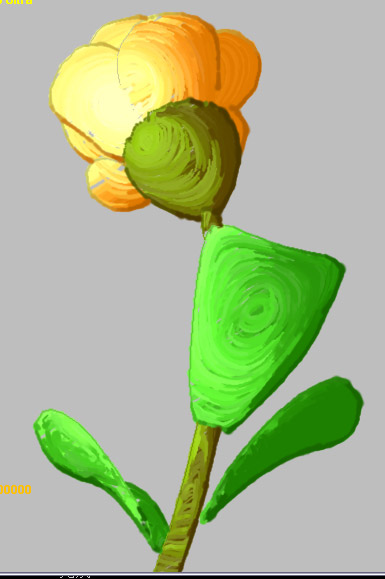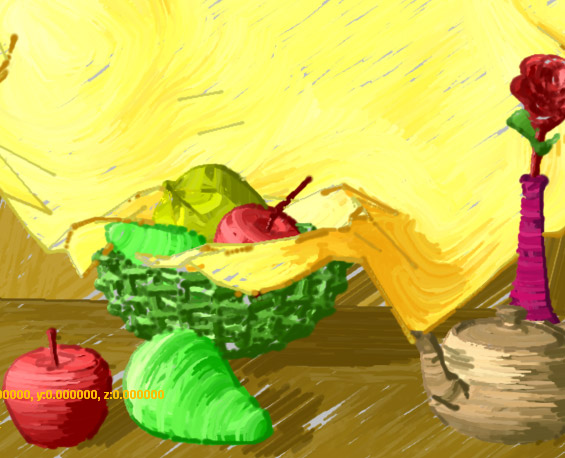Shape-Oriented Brush Stroke Synthesis in Non-Photorealistic Rendering


Non-photorealistic rendering (NPR) has been an important topic in the research field of Computer Graphics. Instead of pursuing the photo-realism of images, researchers of NPR focus on the representation of painting style. Painting style consists of many different elements, such as brush strokes, coloring, texture, composition, subjectivity, intention, exaggerating expression (, i.e. freedom from rigid formalism), and so on. Among these elements, brush strokes and coloring are the most specific, personal and identifiable characteristics for computer graphics. Therefore, simulation and synthesis methods for brush strokes and coloring are one of the mainstreams of NPR research.
According to the types of input resources, approaches of NPR can be roughly divided into two categories, image-based NPR and model-based NPR. Image-based NPR processes two-dimensional images directly by using image-processing techniques mainly. On the other hand, the input data of model-based NPR is three-dimensional models of objects and scenes. Based on the principles of computer graphics including 3D-translation, curvature of model, lighting and shading, the later synthesizes images with NPR effects.
In this paper, by utilizing the information that is extracted from the shapes, we propose a model-based NPR system to simulate several types of brush strokes on a modified z-buffer.
Simulating NPR Watercolor Painting based on the Lattice Boltzmann Method


Non-Photorealistic Rendering (NPR) has been an important research topic in the field of Computer Graphics. Instead of highlighting the realism of CG synthesized images, NPR focus on the representation of the stroke and painter’s style. For the research of NPR watercolor, simulating water diffusion and flow in paper is an important task.
In this paper, we implement a NPR watercolor system. Our scene is composed with 3D models. The special visual effects of watercolor paintings are created by simulating the color mixing and the different concentration of watercolor.
To achieve the above goal and the “Brush-Washing” effect, the water flow on 2D paper is simulated based on the Lattice Boltzmann Method (LBM). Moreover, the strokes of watercolor are simulated by utilizing the auxiliary bone structures and the shapes of three-dimensional models.
A stroke consists of multiple pixels. The color on each pixel is calculated by Phong’s reflection model. Therefore, the color on a stroke gradually transits from pixel to pixel. This approach creates nature and vivid appearances of strokes. In another word, our proposed method creates the tone of strokes automatically based on the 3D information of scene.
As shown in the experiment results, our system synthesizes watercolor NPR animation with interesting and nature color, tone and strokes.
Simulating the Oil Painting in an NPR 3D Animation System


Non-Photorealistic Rendering (NPR) has been an important issue in the field of Computer Graphics. Instead of highlighting the realism of CG synthesized images, NPR focus on the representation of the stroke and paint style. One of the most important features of Non-Photorealistic Rendering is the exaggeration expression over the subjects of image. Therefore, NPR is suitable to synthesize images that simulate the paint style with the visual effect of strokes. The research issues of NPR can be roughly divided into two types, 2D image-based method and 3D model-based method.
In this paper, we synthesize 3D model-based NPR images and animation with continuous volumetric strokes to simulate the visual effects of oil painting. According to our survey on oil paintings, we conclude that the heap of pigment and the volumetric property of each single stroke are two of the most important factors in the works of oil painting. According to the distance from the strokes to the edge of the object, we set up the priority of all strokes. Based on the order, through dynamically segmenting the canvas apart, we make the grouping with regional stroke in the object. And then pile strokes in the same group. The information of the thickness of strokes is stored in a Z-buffer-like data structure. The 3D canvas is then rendered based on this information.
Main contribution of this research includes producing the volumetric strokes, and simulating the oil color correctly on the canvas. These goals are achieved by piling up the strokes on the same pixel, and superposing the pigments to simulate the final resulted color on the canvas.